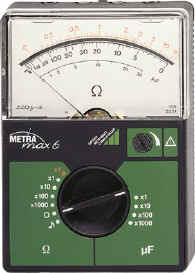Ohmmeter
This article needs additional citations for verification. (November 2012) |

An ohmmeter is an electrical instrument that measures electrical resistance, the opposition to an electric current. Micro-ohmmeters (microhmmeter or microohmmeter) make low resistance measurements. Megohmmeters (also a trademarked device Megger) measure large values of resistance. The unit of measurement for resistance is ohms (Ω).
The first ohmmeters were based on a type of meter movement known as a 'ratiometer'.[1][2] These were similar to the galvanometer type movement encountered in later instruments, but instead of hairsprings to supply a restoring force they used conducting 'ligaments' instead. These provided no net rotational force to the movement. Also, the movement was wound with two coils. One was connected via a series resistor to the battery supply. The second was connected to the same battery supply via a second resistor and the resistor under test. The indication on the meter was proportional to the ratio of the currents through the two coils. This ratio was determined by the magnitude of the resistor under test. The advantages of this arrangement were twofold. First, the indication of the resistance was completely independent of the battery voltage (as long as it actually produced some voltage) and no zero adjustment was required. Second, although the resistance scale was non linear, the scale remained correct over the full deflection range. By interchanging the two coils a second range was provided. This scale was reversed compared to the first. A feature of this type of instrument was that it would continue to indicate a random resistance value once the test leads were disconnected (the action of which disconnected the battery from the movement). Ohmmeters of this type only ever measured resistance as they could not easily be incorporated into a multimeter design. Insulation testers that relied on a hand cranked generator operated on the same principle. This ensured that the indication was wholly independent of the voltage actually produced.
Subsequent designs of ohmmeter provided a small battery to apply a voltage to a resistance via a galvanometer to measure the current through the resistance. The scale of the galvanometer was marked in ohms, because the fixed voltage from the battery assured that as resistance is decreased, the current through the meter would increase. Ohmmeters form circuits by themselves, therefore they cannot be used within an assembled circuit. This design is much simpler and cheaper than the former design, and was simple to integrate into a multimeter design and consequently was by far the most common form of analogue ohmmeter. This type of ohmmeter suffers two inherent disadvantages. First, the meter needs to be zeroed by shorting the measurement points together and performing an adjustment for zero ohms indication prior to each measurement. This is because as the battery voltage decreases with age, the series resistance in the meter needs to be reduced to maintain the zero indication at full deflection. Second, and consequent on the first, the actual deflection for any given resistor under test changes as the internal resistance is altered. It remains correct at the centre of the scale only, which is why such ohmmeter designs always quote the accuracy "at centre scale only".
A more accurate type of ohmmeter has an electronic circuit that passes a constant current (I) through the resistance, and another circuit that measures the voltage (V) across the resistance. According to the following equation, derived from Ohm's Law, the value of the resistance (R) is given by:
For high-precision measurements of very small resistances, the above types of meter are inadequate. This is because the meter's reading is the sum of the resistance of the measuring leads, the contact resistances and the resistance being measured. To reduce this effect, a precision ohmmeter has four terminals, called Kelvin contacts. Two terminals carry the current from the meter, while the other two allow the meter to measure the voltage across the resistor. With this type of meter, any voltage drop due to the resistance of the first pair of leads and their contact resistances is ignored by the meter. This four terminal measurement technique is called Kelvin sensing, after William Thomson, Lord Kelvin, who invented the Kelvin bridge in 1861 to measure very low resistances. The Four-terminal sensing method can also be utilized to conduct accurate measurements of low resistances.
See also
- Megohmmeter
- Ammeter
- Multimeter
- Kelvin bridge
- Measuring instrument
- Electronic test equipment
- Electronics
- Electric circuit
- List of electronics topics
- Series and parallel circuits
- Galvanometer
- Rheochord
References
- ^ http://www.g1jbg.co.uk/pdf/MeggerBK.pdf A pocket book on the use of Megger insulation and continuity testers.
- ^ http://www.prolexdesign.com/images/evohmmeter.jpg Illustration of type. Note the absence of any zero adjustment and the changed scale direction between ranges. [dead link]
External links
- DC Metering Circuits chapter from Lessons In Electric Circuits Vol 1 DC free ebook and Lessons In Electric Circuits series.

